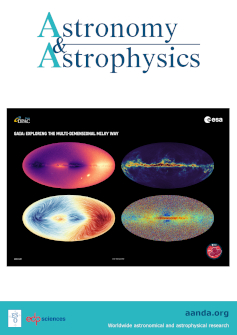An ‘alien’ called the Oosterhoff dichotomy?
IF 5.4
2区 物理与天体物理
Q1 ASTRONOMY & ASTROPHYSICS
引用次数: 0
Abstract
Aims. In this Letter we investigate the origin of the Oosterhoff dichotomy in light of recent discoveries related to several ancient merging events of external galaxies with the Milky Way (MW). In particular, we aim to clarify if the subdivision in terms of the Oosterhoff type between Galactic globular clusters (GGCs) and field RR Lyrae (RRLs) can be traced back to one or more ancient galaxies that merged with the MW in its past.Methods. We first explored the association of GGCs with the past merging events according to different literature studies. Subsequently, we compiled the positions, proper motions, and radial velocities of 10 138 field RRL variables from Gaia Data Release 3. To infer the distances, we adopted the MG–[Fe/H] relation, with [Fe/H] values estimated via empirical relationships involving individual periods and Fourier parameters. We then calculated the orbits and the integrals of motion using the Python library Galpy for the whole sample. By comparing the location of the field RRLs in the energy–angular momentum diagram with that of the GGCs, we determined their likely origin. Finally, using GaiaG-band light curves, we determined the Oosterhoff types of our RRL stars based on their location in the Bailey diagram.Results. The analysis of the Bailey diagrams for Galactic RRL stars and GGCs associated with an ‘in situ’ versus ‘accreted’ halo origin shows remarkable differences. The in situ sample shows a wide range of metallicities with a continuous distribution and no sign of the Oosterhoff dichotomy. Conversely, the accreted RRLs clearly show the Oosterhoff dichotomy and a significantly smaller dispersion in metallicity.Conclusions. Our results suggest that the Oosterhoff dichotomy was imported into the MW by the merging events that shaped the Galaxy.被称为奥斯特霍夫二分法的 "外星人"?
在这封信中,我们根据最近发现的几个外部星系与银河系(MW)古老合并事件,研究了奥斯特霍夫二分法的起源。特别是,我们旨在弄清银河系球状星团(GGCs)和天琴座场RR(RRLs)之间在奥斯特霍夫类型上的细分是否可以追溯到一个或多个在过去与银河系合并的古老星系。我们首先根据不同的文献研究,探讨了GGC与过去合并事件的关联。随后,我们汇编了盖亚数据第3版(Gaia Data Release 3)中的10 138个场RRL变量的位置、顺动和径向速度。为了推断距离,我们采用了MG-[Fe/H]关系,[Fe/H]值是通过涉及单个周期和傅立叶参数的经验关系估算的。然后,我们使用 Python 库 Galpy 计算了整个样本的轨道和运动积分。通过比较场RRL在能量角动量图中的位置和GGC的位置,我们确定了它们的可能起源。最后,利用GaiaG波段光曲线,我们根据RRL恒星在贝利图中的位置确定了它们的奥斯特霍夫类型。对银河系RRL恒星和GGC的贝利图进行分析后发现,"原地 "和 "吸积 "光环起源的RRL恒星和GGC有着显著的差异。原位样本的金属性范围很广,呈连续分布,没有奥斯特霍夫二分法(Oosterhoff dichotomy)的迹象。相反,吸积的RRL则明显显示出Oosterhoff二分法,而且金属性的离散程度要小得多。我们的研究结果表明,Oosterhoff二分法是由塑造银河系的合并事件引入中波的。
本文章由计算机程序翻译,如有差异,请以英文原文为准。
求助全文
约1分钟内获得全文
求助全文
来源期刊

Astronomy & Astrophysics
地学天文-天文与天体物理
CiteScore
10.20
自引率
27.70%
发文量
2105
审稿时长
1-2 weeks
期刊介绍:
Astronomy & Astrophysics is an international Journal that publishes papers on all aspects of astronomy and astrophysics (theoretical, observational, and instrumental) independently of the techniques used to obtain the results.
 求助内容:
求助内容: 应助结果提醒方式:
应助结果提醒方式:


